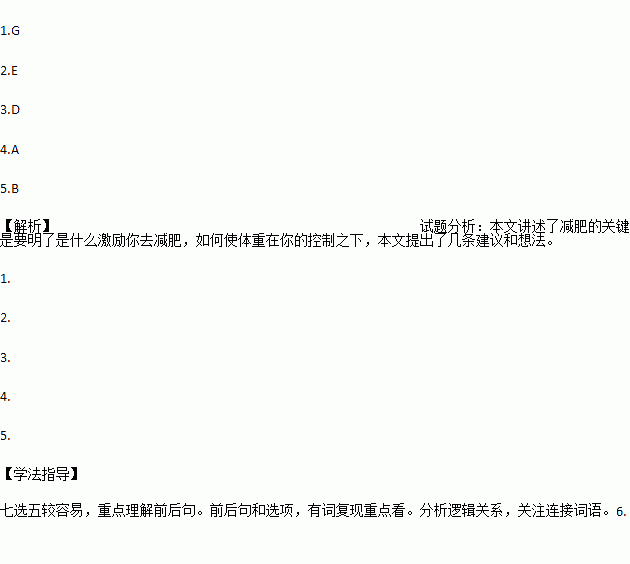题目内容
The key to losing weight is to understand what really motivates you. have you ever been excited about losing a few pounds? 1. And to help you keep your weight under control, you need some coping strategies.
Ask questions. When you’re researching different dieting products and plans or even talking to a doctor about diets, ask as many questions as you can.2.Ask questions like: Do I have to purchase special meals or supplements? Does the program include a part to help me maintain my weight loss?
Get real. 3.Don’t burden yourself with unrealistic expectations. Remember, large amounts of weight loss are not realistic and are most likely not safe or healthy. Talk with your health care professional to determine a healthy weight goal.
4.To maintain your weight, you must balance your intake of calories with the energy you burn. Just 30 minutes of fast walking in most days can take about 10 pounds off your weight each year.
Weight yourself weekly. It’s important to track your weight on any diet or weight loss plan, but don’t get on the scale every day. weighing daily won’t show you the big picture. 5.
A. Stay balanced.
B. Once a week is fine.
C. Stick with your healthy eating plan.
D. Losing one to two pounds a week is a realistic goal.
E. Being well informed will help you choose the best diet for you.
F. Regular weight check-ins will show you your progress over time.
G. If so, you must find a way to turn that excitement into determination.
King's College Summer School
King's College Summer School is an annual training program for high school students at all levels that want to improve their English. The teachers of King’s College and other colleges in New York give courses. Trips to museums and culture centers are also organized. This year's summer school will be from July 25 to August 15. More information is as follows:
Application (申请) date ●Students in New York should send their applications before July 18, 2017. ●Students of other cities should send their applications before July 16, 2017. ●Foreign students should send their applications before July 10, 2017. | Courses Spoken English: 22 hours Reading and Writing: 10 hours ●American History: 16 hours ●American Culture: 16 hours |
Steps ●A letter of self-introduction ●A letter of recommendation ●The letters should be written in English with all the necessary information. | Cost ●Daily lessons: $200 ●Sports and activities: $100 ●Travels: $200 ●Hotel service: $400 ●You may choose to live with your friends or relatives in the same city. |
1.You can most probably read the text in _____.
A. a newspaper B. a travel guide
C. a textbook D. a telephone book
2.Which of the following is true about King's College Summer School?
A. Only top students can take part in the program.
B. Only the teachers of King' s College give courses.
C. King' s College Summer School is run every other year.
D. Visits to museums and culture centers are part of the program.
3.If you are to live with your relatives in New York, you will have to pay the school _____.
A. $200 B. $400
C. $500 D. $900
4.What information can you get from the text?
A. The program will last two months.
B. You can write to Thompson only in English.
C. You can get in touch with the school by e-mail or by telephone.
D. As a Chinese student, you can send your application on July 14, 2017.


